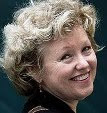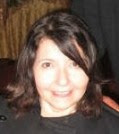
By Caitlin Rother
One thing I've learned in my career as a full-time author is that it’s crucial to try to break up my daily routine – working at the computer, doing research and conducting phone interviews in isolation at home – with intermittent human contact and a variety of mental and physical activity. In other words, balance.
A couple weeks ago, I was celebrating the joy of hearing my editor finally utter the welcome phrase, "I'm putting the book into production" – the first step to getting my final advance payment – with a spontaneous outing at my neighborhood bar and grill. There, I met Kirsten, a fifth-grade teacher from the largely Latino community of National City, and later that evening, she emailed me to ask if I had time to help her students put out a newspaper at Biztown, a Junior Achievement program here in San Diego.
“Not really,” I wrote, “but it seems like a good idea, so I'm going to do it anyway.”
I said yes partly because I was still amazed at how only 90 minutes of chatting at the bar with Kirsten and Barbarella, a columnist for the San Diego Reader, had really brightened my day, all of which brought home my original points about human contact and striving for balance. But I also predicted it would be an important and gratifying experience to inspire young minds to think about journalism as a career choice. Our society NEEDS watchdog reporters to function properly even though most young people today don't want to pay for news content they’re used to getting for free on the Internet.
That Monday morning, I met the seven youngsters who would put out a newspaper called The San Diego U-T, which, by no coincidence, is the name of the paper I left in 2006 after 13 years to write books full-time. Two of the boys were impressively wearing ties – one of them even sporting a dark suit with his tennis shoes – when they walked in to greet me and Stephanie, the other adult volunteer at our business. She and I split up oversight duties, with her taking the business side and me handling the two reporters, one editor and one photographer. Kirsten stopped in at times and helped, too.
As the morning went on, our job became more challenging because the kids were given progressively longer breaks to spend their two enormous $8 paychecks, which they first had to cash at the pretend bank around the corner. I had to chuckle at the irony when our CEO forgot to sign one batch of paychecks, then managed to bounce his own, forgetting that he’d already been given $2 in cash (green play money) when he wrote a check for his entire $8.
Unfortunately, our instructions weren't very specific, so I didn't learn that my small staff needed to write a total of six stories until we were only 30 or 40 minutes away from deadline – and fifth graders aren't the fastest writers let alone typists. I have no children myself, so I have little experience with kids this age, but these ones seemed easily distracted by all the activity going on around them. I didn't want to do their thinking for them, however we also had a deadline to meet and it came upon us like a tidal wave. At that very moment, I knew exactly how one of my former bosses must have felt in the late afternoon when he asked me to step in for other reporters to finish their stories as well as my own.
As the minutes clicked by, I had only one reporter to work with who wasn't on a break, and she became my lifeline. With me at the keyboard – there was no other way to get this done in time if I let her do the typing – little Carolina Ocanas, thankfully my best and fastest writer, and I whipped out the rest of the stories. I tried to let her do as much on her own as I could, and she wrote two stories under her byline, we finished one each that our editor, Mario Rodriguez, and reporter Karla Herrera had started, and I typed in the one that Karla had written by herself.
Like Carolina and our CFO Alexandra, many of the Biztown kids worked hard and took their jobs seriously, some not so much, just like in the real world. Our team got the paper out and managed to coordinate photos with story content, just like at a real newspaper. We overcame a few other mishaps – also no different from a real paper: the printer toner ran out and one computer kept printing one of the wrong pages so our staff guy had to keep reproducing the double-sided page. The kids made advertising posters with crayons and construction paper, but failed to notice that the tape to display them was right there on the table, so they hand-carried them around, then later hand-delivered the papers as they came out of the printer in two sets (pre- and post-toner problems).
The kids decided to charge two dollars per paper (most products at Biztown sold for $3 to $5) and we managed to sell nearly 25 of them to the group of 99 students. Given the problems the newspaper industry is experiencing nationwide, it was heartwarming to see 25 percent of the children line up to buy a paper for 25 percent of a single paycheck.
My volunteer stint was exhausting but rewarding, and I hope that I was able to impart some of my enthusiasm to my young mentees the same way I've done for some of my adult students at UCSD Extension, where I teach journalism and creative writing classes. As I tell my older students, journalism is harder than it looks and it does take a while to learn how to write a good story. But based on the number of papers we sold, it was evident that kids do see their value, so maybe there is hope for journalism yet.
One thing I've learned in my career as a full-time author is that it’s crucial to try to break up my daily routine – working at the computer, doing research and conducting phone interviews in isolation at home – with intermittent human contact and a variety of mental and physical activity. In other words, balance.
A couple weeks ago, I was celebrating the joy of hearing my editor finally utter the welcome phrase, "I'm putting the book into production" – the first step to getting my final advance payment – with a spontaneous outing at my neighborhood bar and grill. There, I met Kirsten, a fifth-grade teacher from the largely Latino community of National City, and later that evening, she emailed me to ask if I had time to help her students put out a newspaper at Biztown, a Junior Achievement program here in San Diego.
“Not really,” I wrote, “but it seems like a good idea, so I'm going to do it anyway.”
I said yes partly because I was still amazed at how only 90 minutes of chatting at the bar with Kirsten and Barbarella, a columnist for the San Diego Reader, had really brightened my day, all of which brought home my original points about human contact and striving for balance. But I also predicted it would be an important and gratifying experience to inspire young minds to think about journalism as a career choice. Our society NEEDS watchdog reporters to function properly even though most young people today don't want to pay for news content they’re used to getting for free on the Internet.
That Monday morning, I met the seven youngsters who would put out a newspaper called The San Diego U-T, which, by no coincidence, is the name of the paper I left in 2006 after 13 years to write books full-time. Two of the boys were impressively wearing ties – one of them even sporting a dark suit with his tennis shoes – when they walked in to greet me and Stephanie, the other adult volunteer at our business. She and I split up oversight duties, with her taking the business side and me handling the two reporters, one editor and one photographer. Kirsten stopped in at times and helped, too.
As the morning went on, our job became more challenging because the kids were given progressively longer breaks to spend their two enormous $8 paychecks, which they first had to cash at the pretend bank around the corner. I had to chuckle at the irony when our CEO forgot to sign one batch of paychecks, then managed to bounce his own, forgetting that he’d already been given $2 in cash (green play money) when he wrote a check for his entire $8.
Unfortunately, our instructions weren't very specific, so I didn't learn that my small staff needed to write a total of six stories until we were only 30 or 40 minutes away from deadline – and fifth graders aren't the fastest writers let alone typists. I have no children myself, so I have little experience with kids this age, but these ones seemed easily distracted by all the activity going on around them. I didn't want to do their thinking for them, however we also had a deadline to meet and it came upon us like a tidal wave. At that very moment, I knew exactly how one of my former bosses must have felt in the late afternoon when he asked me to step in for other reporters to finish their stories as well as my own.
As the minutes clicked by, I had only one reporter to work with who wasn't on a break, and she became my lifeline. With me at the keyboard – there was no other way to get this done in time if I let her do the typing – little Carolina Ocanas, thankfully my best and fastest writer, and I whipped out the rest of the stories. I tried to let her do as much on her own as I could, and she wrote two stories under her byline, we finished one each that our editor, Mario Rodriguez, and reporter Karla Herrera had started, and I typed in the one that Karla had written by herself.
Like Carolina and our CFO Alexandra, many of the Biztown kids worked hard and took their jobs seriously, some not so much, just like in the real world. Our team got the paper out and managed to coordinate photos with story content, just like at a real newspaper. We overcame a few other mishaps – also no different from a real paper: the printer toner ran out and one computer kept printing one of the wrong pages so our staff guy had to keep reproducing the double-sided page. The kids made advertising posters with crayons and construction paper, but failed to notice that the tape to display them was right there on the table, so they hand-carried them around, then later hand-delivered the papers as they came out of the printer in two sets (pre- and post-toner problems).
The kids decided to charge two dollars per paper (most products at Biztown sold for $3 to $5) and we managed to sell nearly 25 of them to the group of 99 students. Given the problems the newspaper industry is experiencing nationwide, it was heartwarming to see 25 percent of the children line up to buy a paper for 25 percent of a single paycheck.
My volunteer stint was exhausting but rewarding, and I hope that I was able to impart some of my enthusiasm to my young mentees the same way I've done for some of my adult students at UCSD Extension, where I teach journalism and creative writing classes. As I tell my older students, journalism is harder than it looks and it does take a while to learn how to write a good story. But based on the number of papers we sold, it was evident that kids do see their value, so maybe there is hope for journalism yet.
Caitlin Rother, a Pulitzer-nominee who worked as a investigativer reporter for nearly 20 years, is the author of five books, including Body Parts, Twisted Triangle, Naked Addiction, and Poisoned Love, and is the co-author of Where Hope Begins and My Life, Deleted. Her next book, Dead Reckoning, the story behind the murder of Tom and Jackie Hawks by Skylar Deleon and his clan of outlaws, including his wife Jennifer will be out in February. She is currently working on a book about the John Gardner murder case. For more information, check out her Web site, caitlinrother.com.












3 comments:
That is a truly heart-warming story, Caitlin. And, knowing you, I am impressed with your finding the time to do this! I am sure you created an experience that will continue to inspire--not only those kids but the rest of us writers who love hearing about enthusiasm for the written word being stoked
Thanks, Kathy! Glad you enjoyed it. Honestly, taking five hours away from the book stuff gave me a nice break and made me more efficient when I got back to work -- at least that's what I told myself. Let's hope my experience inspires some folks to volunteer and/or write on their own and strive for some balance in their lives.
Sometimes, it seems, we spend more time coming up with excuses and figuring out why we can't do something for others in the midst of our busy lives (and feeling guilty about it) than actual doing it. Bravo, Caitlin. You've inspired me, too. And, I'm sure you've made a difference in the lives of those budding journalists.
Post a Comment